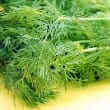Background
- Dill (Anethum graveolens), a hardy, short-lived perennial herb native to the Mediterranean and southern Russia, grows wild in Spain, Portugal, and Italy. Dill's name comes from the Old Norse word dilla, which means "to lull" or "soothe," possibly referring to its antigas and digestive-aiding properties. The ancient Egyptians, Romans, Chinese, and Vikings relied on its stomach-settling properties.
- Scientific research on the uses of dill is limited. In preliminary research, dill has demonstrated dose-dependent cholesterol-lowering effects. At this time, clinical evidence supporting the efficacy of dill for any indication is limited.
- Both dill seeds and leaves are used as a spice. Dill is listed on the U.S. Food and Drug Administration (FDA) Generally Recognized as Safe (GRAS) list.
References
Natural Standard developed the above evidence-based information based on a thorough systematic review of the available scientific articles. For comprehensive information about alternative and complementary therapies on the professional level, go to . Selected references are listed below.
- Bahramikia S, Yazdanparast R. Efficacy of different fractions of Anethum graveolens leaves on serum lipoproteins and serum and liver oxidative status in experimentally induced hypercholesterolaemic rat models. Am J Chin Med 2009;37(4):685-699.
View Abstract - Chiu AM, Zacharisen MC. Anaphylaxis to dill. Ann Allergy Asthma Immunol 2000;84(5):559-560.
View Abstract - Fodor JI, Keve T. [New phytotherapical opportunity in the prevention and treatment of 2-type of diabetes mellitus]. Acta Pharm Hung 2006;76(4):200-207.
View Abstract - Freeman GL. Allergy to fresh dill. Allergy 1999;54(5):531-532.
View Abstract - Gundling K, Kojuri J, Vosoughi A, et al. Bacteriostatic effect of dill, fennel, caraway and cinnamon extracts against Helicobacter pylori. J Nutr Environ Med 2005;15(2-3):47-55.
- Hajhashemi V, Abbasi N. Hypolipidemic activity of Anethum graveolens in rats. Phytother Res 2008;22(3):372-375.
View Abstract - Kaur GJ, Arora DS. Antibacterial and phytochemical screening of Anethum graveolens, Foeniculum vulgare and Trachyspermum ammi. BMC Complement Altern Med 2009;9:30.
View Abstract - Kojuri J, Vosoughi AR, Akrami, M. Effects of anethum graveolens and garlic on lipid profile in hyperlipidemic patients. Lipids Health Dis 2007;6:5.
View Abstract - Monteseirin J, Perez-Formoso JL, Hernandez M, et al. Contact urticaria from dill. Contact Dermatitis 2003;48(5):275.
View Abstract - Monsefi M, Ghasemi M, Bahaoddini A. The effects of Anethum graveolens L. on female reproductive system. Phytother Res 2006;20(10):865-868.
View Abstract - Pieroni A, Gray C. Herbal and food folk medicines of the Russlanddeutschen living in Kunzelsau/Talacker, South-Western Germany. Phytother Res 2008;22(7):889-901.
View Abstract - Panda S. The effect of Anethum graveolens L. (dill) on corticosteroid induced diabetes mellitus: involvement of thyroid hormones. Phytother Res 2008;22(12):1695-1697.
View Abstract - Sadeghian S, Neyestani TR, Shirazi MH, et al. Bacteriostatic effect of dill, fennel, caraway and cinnamon extracts against Helicobacter pylori. J Nutr Environ Med 2005;15(2-3):47-55.
- Stannard J. The multiple uses of dill (Anethum graveolens L.) in medieval medicine. Wurzbg Medizinhist Forsch 1982;24:411-424.
View Abstract - Wahba NM, Ahmed AS, Ebraheim ZZ. Antimicrobial Effects of Pepper, Parsley, and Dill and Their Roles in the Microbiological Quality Enhancement of Traditional Egyptian Kareish Cheese. Foodborne Pathog Dis 2009;
View Abstract







